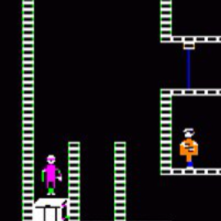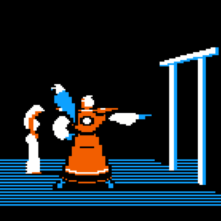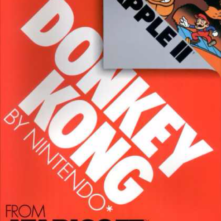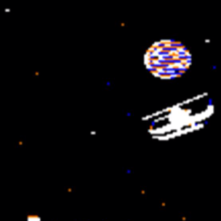Beta-testing Wolfenstein 3D
| April 13th, 2020 1:06 PM by Ken Gagne | Filed under Game trail, Happenings, History; 1 comment. |
Years after the last Apple II rolled off the production line, there was still a lot of commercial and shareware software being developed for the IIGS. In the heyday of the GEnie online service, I somehow fell into a group beta testers of new programs for companies such as InTrec and Seven Hills.
One developer I especially enjoyed working for was Eric "Sheppy" Shepherd. His website of eponymous SheppyWare lists many programs I got to try before they were ready for prime time, such as gsAIM, Lemonade Stand, Shifty List, and WebWorks GS.
But the beta I most enjoyed was that for Wolfenstein 3D. The port had been a long time in development, with many parties involved: id Software, Logicware, Burger Becky, and Ninjaforce, to name a few. It was Sheppy who developed and project-managed the final release of this first-person shooter that had been so popular on my friends’ MS-DOS machines.
But I’ve never owned a desktop computer that wasn’t an Apple II, so Wolf3D had been something I’d only been able to envy without playing. Gaming was my Apple II niche — I got my start with Juiced.GS writing a review of Silvern Castle — so I was eager to finally dive into the heralded game.
Perhaps too eager. The Apple IIGS emulator of choice for Mac OS in the mid- to late 1990s was Bernie ][ the Rescue, so I booted up Bernie on my Wall Street and promptly launched Wolf3D.
CRASH! The game failed almost immediately. I was disappointed to not get my hands on the game, but also excited to contribute to the beta-testing process. I was certain I had acted so swiftly that no one else could’ve yet encountered this blocker of a bug. Without checking to see if that was true, I reported back to the testing group: "Hey, it crashes Bernie!"
In my haste to submit my first bug, I had completely ignored the release notes that had accompanied this version of Wolf3D, indicating that it was incompatible with Bernie ][ the Rescue. 🤦🏼♂️
Just a few months later, in the summer of 1998, I attended my first KansasFest. It was my first time meeting Sheppy and my fellow beta-testers, such as Ryan Suenaga and Dave Miller. We were celebrating the successful release of Wolf3D for the IIGS earlier that year, with Sheppy hosting a post-mortem of the game’s development, giving all KansasFest attendees a peek behind the scenes.
It was there, at my first KansasFest, in front of all my friends and heroes, that I was stunned to receive a certificate of acknowledgement for my significant contribution to the development of Wolfenstein 3D.
Sheppy wasn’t singling out the new guy, though — every beta tester got their turn. As reported a month later by Ryan Suenaga in in The Lamp!:
Sheppy also presented the _Wolfenstein 3D Beta Tester Awards_, for those of us who had gone through the intense last few weeks of beta testing for the most eagerly anticipated Apple IIgs game in history. The history behind these awards is too long to go into here–use your imagination:
- Dan Krass: The Web Banner Plaque of Honor
- David Miller: The ProTERM Mac Can Do It Citation
- Ken Gagne: The "Hey, It Crashes Bernie" Certificate
- Kirk Mitchell: The "Boy, Is This Fast on My G3" Award
- Ryan Suenaga: The Floppy Disk Loaner Citation of Valor
- Tony Diaz: The Last-Minute Crisis Award of Merit
- Tony Ward: The Custom Scenario Proponent Citation
Perhaps I should’ve been mortified to have had my youthful exuberance enshrined in such a public and memorable manner. But instead, I was and am grateful to Sheppy for the wonderful opportunity to test Wolfenstein 3D and for being including in his community — not only of beta testers, but of friends he could count on to take a joke. I found everything I hoped for at KansasFest 1998; it’s thanks to memories like these that I’ve been a part of KansasFest and the Apple II community ever since.

















